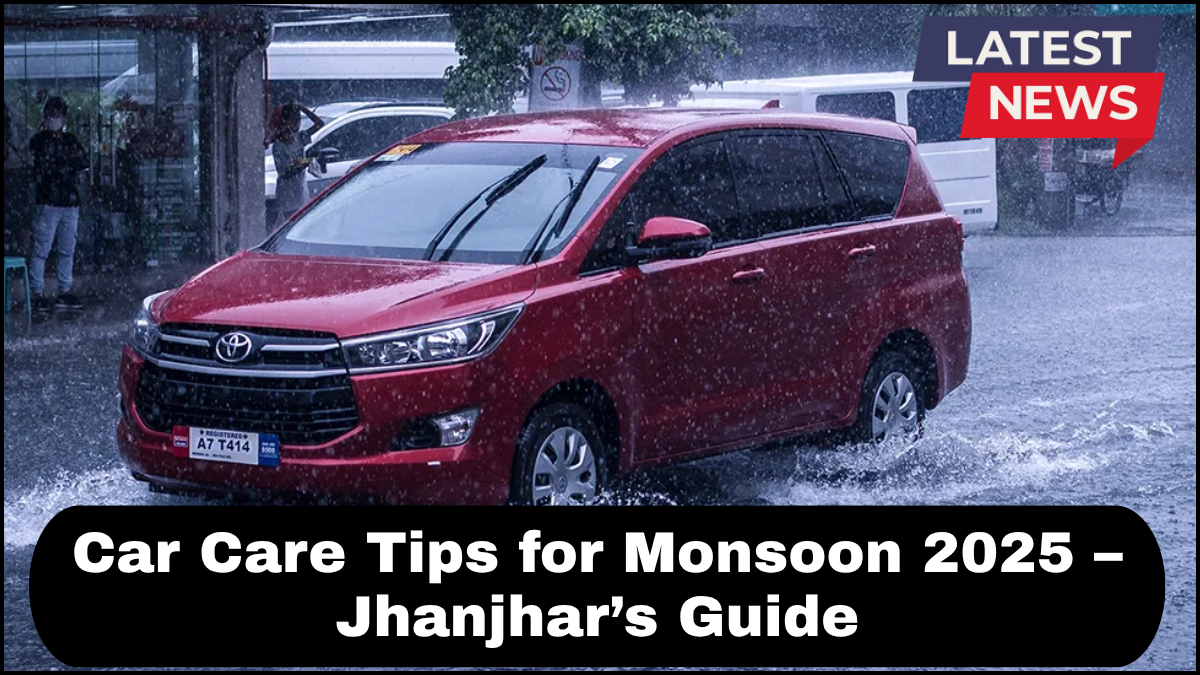The monsoon season in India brings much-needed relief from the heat—but it also brings challenges for car owners. From water-logged roads to reduced visibility, this time of year can test your vehicle’s reliability. To help you stay safe and keep your car running smoothly, Jhanjhar presents the ultimate Monsoon Car Care India 2025 guide.

Let’s break it down into practical, actionable steps tailored for Indian weather and driving conditions.
Inspect and Replace Wiper Blades
Wiper blades take a beating in the summer heat, and by monsoon, they often underperform. Cracked, squeaky, or streaking wipers are a hazard during heavy rain.
-
Tip: Replace wiper blades at the start of the season. Use high-quality rubber or silicone blades that handle Indian rainfall.
-
Check washer fluid levels and add rain-repellent additives if necessary.
Check Tyre Tread and Air Pressure
Wet roads mean reduced grip. Tyres with worn-out treads can skid easily, especially during sudden braking.
-
Tread depth: Ensure at least 2.5 mm depth for effective traction.
-
Air pressure: Avoid over-inflating. Slightly lower pressure increases the surface grip on wet roads.
-
Rotate tyres if needed to maintain even wear.
Seal the Electrical System
Moisture and electronics don’t mix. Exposed wiring or weak insulation can cause short circuits or battery drainage.
-
Battery: Inspect terminals for corrosion and ensure a tight fit.
-
Fuses and wiring: Have a technician check for exposed or cracked wires.
-
Tip: Apply a protective dielectric grease on terminals to resist moisture.
Get the Brakes Checked
Braking systems face more pressure in rainy conditions. Water can reduce braking efficiency and cause rust.
-
Brake pads: Ensure they aren’t worn out or squeaky.
-
Brake fluid: Top it up if needed, and look for leaks.
-
ABS function: Test your anti-lock braking system before monsoon driving.
Protect the Undercarriage
Indian roads flood fast, especially in low-lying areas. This makes the car’s undercarriage vulnerable to rust and mechanical wear.
-
Underbody coating: Invest in anti-rust coating. It protects against water damage and salt exposure.
-
After every drive: Rinse off mud and debris stuck to the undercarriage.
Ensure Proper Lighting
Monsoon means reduced visibility—not just for you, but also for other drivers. Faulty lights are a serious safety risk.
-
Headlights: Check alignment and brightness. Upgrade to LED or projector lamps for better visibility.
-
Brake and tail lights: Ensure all bulbs are working.
-
Fog lights: If you drive in areas with heavy rain or mist, install front and rear fog lamps.
Interior and Cabin Tips
Humidity breeds mold and mildew, especially if water seeps inside.
-
Floor mats: Use waterproof or rubber mats instead of fabric ones.
-
Check door seals: Replace cracked or loose rubber beading to prevent water leakage.
-
Use a dehumidifier pouch or silica gel packs inside the cabin to reduce dampness.
Keep an Emergency Kit
In case you get stuck or stranded during a storm, your rainy season vehicle tips toolkit should include:
-
A flashlight
-
Jumper cables
-
Tow rope
-
Tyre inflator or portable air compressor
-
Raincoat or umbrella
-
First-aid kit
This kit could make a huge difference during unexpected breakdowns.
Drive Smart, Not Fast
During the monsoon, the road is unpredictable. Prioritize safety over speed.
-
Avoid sudden braking.
-
Maintain a safe distance.
-
Slow down near puddles—you never know what lies beneath.
-
Stay updated on weather alerts and avoid driving during extreme rainfall if possible.
Extra Care for Monsoon Car Care India 2025
In 2025, car tech is smarter than ever, but not immune to rain-related issues.
-
Sensor check: Have your ADAS (Advanced Driver Assistance Systems) and parking sensors tested for moisture protection.
-
Hybrid/Electric Vehicles: Ensure battery enclosures are sealed properly. Water exposure can disrupt electric systems.
FAQs on Monsoon Car Care in India 2025
Q1: How often should I check my car during the monsoon season?
You should perform a quick check before and after each rainy day drive. A full inspection every 2–3 weeks is ideal.
Q2: Is ceramic coating useful for monsoons?
Yes. Ceramic coating adds a water-repellent layer to the paint, making it easier to clean and protecting the surface from rain and grime.
Q3: Can I drive through flooded roads if my car is new?
No. Even new cars are vulnerable to water entering the air intake or exhaust. Avoid driving through water deeper than half your tyre height.
Q4: What’s the best way to dry a soaked car interior?
Use a vacuum cleaner with a wet suction feature, keep windows slightly open under shade, and place moisture-absorbing pouches inside.
Q5: Are there specific rainy season vehicle tips for EVs?
Yes. Check the insulation of battery compartments, and avoid deep water as EVs are heavier and harder to tow if stuck.
clcik here to learn more